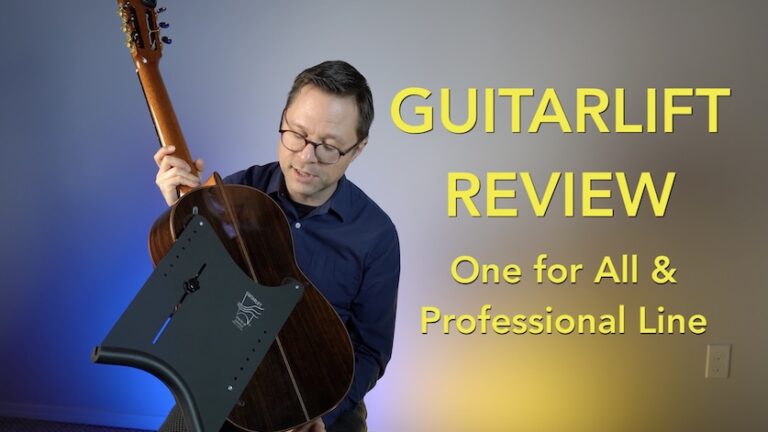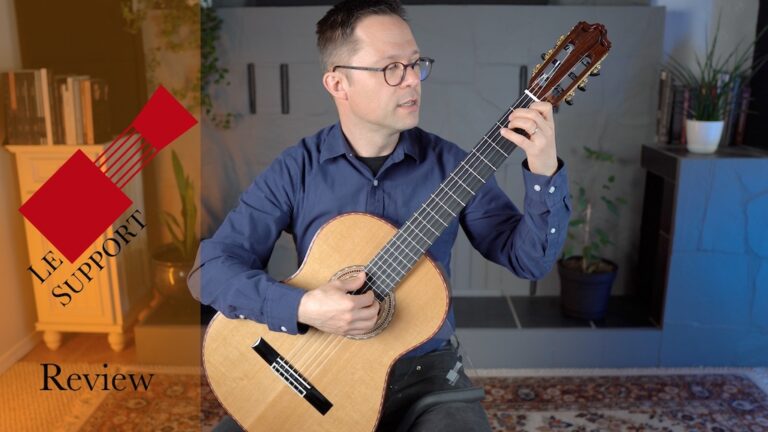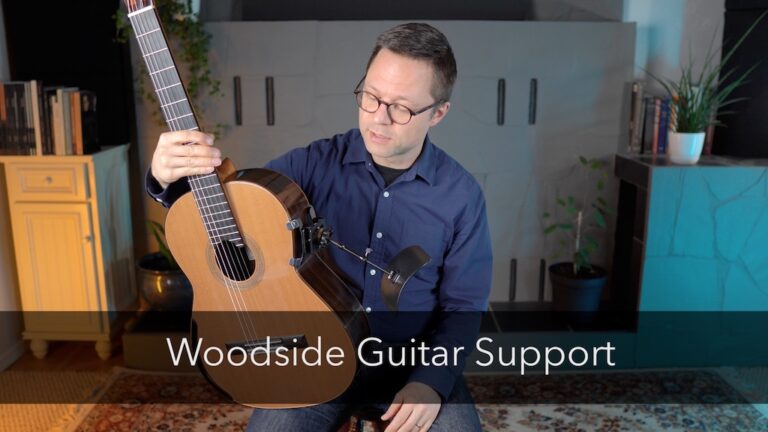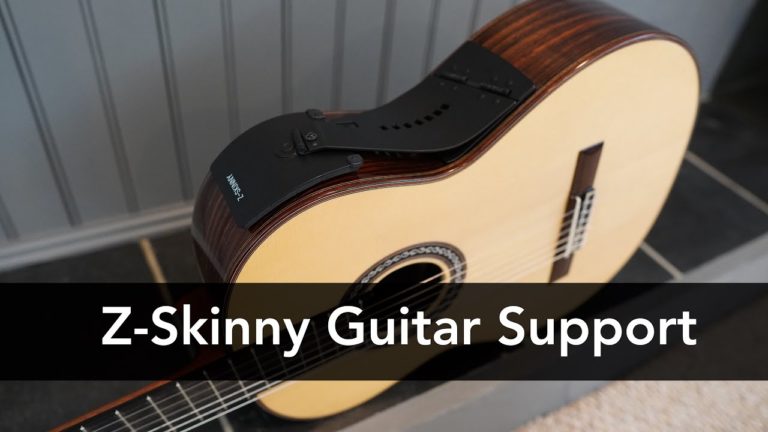I recently lent my Ergoplay Guitar Support to a student and realized that it worked as ‘training wheels’ for the student’s guitar position. In other words, because guitar supports essentially put the guitar at approximately a 45 degree angle, the student automatically sits with the guitar in an optimal position. After two weeks of sitting properly the student, after returning to the footstool, wanted to sit with a good position. It showed the student the benefits of sitting properly and instilled a good habit without much effort from the student.
Maybe all students should start with a guitar support and then find their preferred method of elevating the guitar. The student I first mentioned has decided to stick with the footstool but her position has been great every since.
Teachers: What do you think ?





I personally do not use this guitar technique because I tend to arch my hand very high but probably the most ergonomic one out there.
http://www.mangore.com/carlevaro-technique-2-9-53
Why not try to stand with guitar?
Using strap.
I play guitar around 50 years .
Sitting, standing, using footstool etc.
Last 25 years almost ecxlusively with the strap in free standing position.
It is the best position for me.
And latest science data confirms it… sitting in general and especially with guitar, is not healthy position for for our spines.
I advice to try playing standing.
I have a small video on youtube explaining strap positioning.
please take a look!
Good luck with your guitar journey!
Andrei Krylov
Quebec, Canada
Hey John. It’s interesting to take up a challenge like playing CG at our age, isn’t it?
So far I have crafted three different versions of my own foam support modelled on the Dynarette. None of the three is exactly right, but I decided to give my DIY labours a rest for a while. If I concoct one that really works for me I’ll put up some photos.
My problem with the Dynarette is similar to your experience with the Ergoplay. That is, the guitar position is a bit insecure. Moreover, I cannot get the guitar centred laterally as it should be – the top edge of the guitar touches my chest to far to my left. I thought I would get used to that, but in fact it created a whole other pain problem. I developed nasty neck cramps on the right side, and fairly severe pain between my right shoulder blade and my spine. I finally figured out that I was tensing up trying to hold the guitar securely.
So far now I am back using a foot stool.
It is possible that the main issue for me is not the device and precise position so much as it is body conditioning. I have been breaking my daily practices into two sessions of an hour each. On top of that I do 30 minutes on an elliptical machine, and about 30 minutes of upper body work before my first practice, and then about 20 minutes of stretching after my second practice. I have to do the “tennis elbow” stretches with a Thera-Band Flexbar to keep my left forearm from seizing up.
My technique is still in a state of flux, as I have only been playing for a short time. I am quite aware that I use waaaay too much force fretting with my left hand. This is maddeningly difficult to cure, but I am convinced that it is at least partly at the root of my left forearm problems.
Anyway, best of luck. I’ll post more if I have a breakthrough (for myself) on this.
– Jake –
I have found this discussion most interesting, particularly as (a) I’m a 65yo just starting my CG journey, (b) sadly with a body having significant lower back damage due to a previous accident and hence (c) the ongoing struggle to find a good body position. I’m a 180cm tall Aussie (which I think is about 5’11”) and find I need a chair height of around 23″ as a primary consideration.
So far I have tried the foot stool: a height of about 6″ is OK for creating a workable position for me but after 30 – 45 mins of practice I can hardly move in my lower back. So then tried the Ergoplay: certainly allowed a little less lower back pain and tension as both feet, knees and legs were in a more natural flat position and the instrument also was in a more traditional 45 deg position. But I actually found the guitar felt quite insecure as my right arm did not seem to balance it against my left arm and thigh as well. After several days of constantly adjusting the Ergoplay’s component angles I finally gave up. Moreover as I live in quite a tropical part of the country I found the supplied suction cups pretty ineffective after about 15 minutes.
Just before Christmas I borrowed a friend’s Gitano: initially a tad sceptical I must admit but the Gitano seemed to allow me to almost unconsciously continually wriggle and shift into a playing position that gave reasonable lower back comfort and seemed to produce a reasonable level of LH/RH positioning (well for a relative newbie anyway). Looking in the mirror when using the Gitano I think because it is much shorter in length than the Ergoplay, it seems to seems to offer me more flexibility of positioning on my left thigh than the Ergoplay. Strangely neither of the suction cups let go during the week I used this support.
I also noticed in an earlier post of this topic from a fellow Aussie (in Perth) saying that she experienced significant lower back problems and now uses a Dynarette and finds it very good – I may try the DIY approach here with some small home cushions to see how this may work for me given her comments.
I also would be interested to hear of Jake’s DIY outcome as I often find using our own ingenuity generally manages to resolve the issue at hand and like Jake I also use Thera-Band products to improve the strength and flexibility of my fingers/hands
More on the Dynarette. I have the small version as I am short. (My stature may also be the source of some of my problems, as mentioned by Don Porter.) Anyway, the Dynarette is almost but not quite right for me. So, I am experimenting with making my own foam version using high density foam and an electric carving knife to shape foam layers. My guess is that the DIY approach will yield a support that truly works for me.
Hi Jake,
How short is short… ROFL
I’m 5’7″ and got the Small. It arrived yesterday and it seems OK so far. The descriptions on Amazon are a bit confusing.
The DIY method will guarantee that you get what you want.
I’m 5’7″ also. I used to be an inch taller, but with age my spine has compressed. I am now a bow-legged hobitty little guy who plays guitar sort of.
Great comments everyone, hearing from a wide range of people is really interesting. I think the main thing we can all agree upon is that the sitting position is very important to long-term health. It’s not going to be the same for everyone so discovering what works and what helps for the individual is key. Also, as Don pointed out, additional exercises and solving underlying issues with pain, tension, and past injury can be contributing factors.
In regards to the article above I am referring to beginner guitarists. In other words, guitar students with obvious position problems rather than long term players. So, my question is, do you all think guitar supports help support a general good position for beginners or not. I would have to say that on average it gets the student into a better place than footstools do. Even though most my students and I generally use a footstool anyway.
Hi Bradford,
Yes, to answer your original question – I much prefer using supports as they do encourage better posture. I don’t like ergo play. They keep falling off the guitar. I bought neck-up, which i consider superior to ergo play but more expensive. However, the quality of neck-up supports has declined. Compared to my teacher’s neck-up the quality of leather has decreased so the leather often slips off the cups and the suction cups are now smaller so they also slip off the guitar mid performance. I’m attracted to the clamp-style supports and wonder if they are any better?
Hey Donald,
Thanks so much for sharing your information. I’m just learning guitar and having lots of physical issues with my right neck and shoulder and left wrist. My right buttock falls asleep all the time, and my left leg gets so cramped it’s hard to stand up after playing a bit. I’m wondering if you could tell me some specific exercises you do to counter the physical effects of sitting and playing. (I’m much shorter than you — 5’2″)
Thanks!
Hi Rane,
Actually, I learnt an important lesson recently. I finally had my issue properly diagnosed by an excercise physiologist – someone with experiencce in hospital wards. My problem was a drooping right shoulder. I now have a specific set of targeted stabilisation and strengthening exercises that seem to be addressing the issue effectively. Relaxing my shoulder while playing guitar was contributing to overall problems as it added to an artficial droop which, in turn, caused pain and tension down my back, hip, arms, hands, and shoulders. So, while I agree the relaxation is critical to playing guitar well, when we have specific problems, relaxation can also contribute to those problems unless they are properly identified and remedied. For this reason, I will not recommend any set of exercises, but stress the importance of seeing a well- qualified specialist to resolve your issues. It took me years to find the right specialist, which turned out to be an exercise physiologist, or someone who is exerienced in retraining people, who have a myiad of conditions.
I hope this helps. I am surprised at how much difference my treatment has made to my overall freedom when playing. I should add that students really do need to find a well qualified or trained classical guitar teacher who can address all of their technical issues correctly, as well. What a classical guitar teacher cannot advise you on is biomechanics of the human body.
Regards,
Don.
Hello all,
I have been reading your articles for the last few months. All the information you provide are so usefull to us poor uneducated Flamenco guitarists!
I have been playing flamenco professionally for the last 45 years. Here is my vue of this problem.
Pain all over the body is part of the game for us, regardless of posture, relaxation techniques or even guitar supports we may use!
Personnaly I have tried many different postures. The ones that cause the least problems are:
– first and foremost: the classic flamenco posture where the bottom of the guitar rests on the right tie, (Say like Sabicas ?)
– and second: the regular classical position like is shown above by Sophie.
Anything else (particularly the so-called P.Lucia posture where the right leg is crossed over the left knee at a 90 degree angle…crazy!!!) including all supports have proven to be useless.
Over the years I found that changing posture as well as the hight of the seats I use, say every week or so, helps trick the body into overcoming the difficulties related to playing long long long hours on this totally un-ergonomic instrument. Another little trick that works for me is using different sized instruments. For comparison sake let’s say a typical size flamenco guitar which is rather smaller and thinner (for a week?) and then a typical classical guitar which overall is larger and thicker (for the next week). i..e different sized instruments, different string hights and tensions, different right hand attack angles etc.
Sometimes I wish I had taken-up piano instead of the guitar!
Hope this is of help to some of you outhere.
Roger
I strongly agree with Donald Porter’s comment above. I keep hearing that developing “good” playing posture will prevent problems. BUT – I believe that no matter how you cut it, the physical activity of playing classical guitar requires an entirely unnatural and highly stressful body position. I actually don’t believe that there is really a stess-free posture, only worse and somewhat less worse, so to speak.
I have been playing classical guitar seriously since about June of this year (2013). Before that I tinkered around on my electric and steel string guitars for many years. Despite my rather careless approach to posture in years past, I could play those instruments for hours on end without trouble. It was only when I started playing classical that arm and back problems showed up. I have spent about $150 on various support devices, the latest being a Dynarette cushion.
I developed some nerve problems in my left hand and arm from playing. Only by going to a physical therapist have I been able to get some relief. My therapist says I must “cross train” just like an athlete to handle the physical stress of playing. (I practice two hours per day in two separate one hour sessions, lots of stretching, heat, and some massage before playing, and ice and some stretching afterward.) After a few sessions with the therapist the pain diminished sufficiently to allow me to use Thera-Band elastic strips and a Thera-Band Flexbar for strengthening my back and arms.
With respect to everyone’s personal experiences, I’ve been playing for around 20 years with the last 10 years being pretty intensive. I practice for hours and teaching for 6-7 hours on top of that. I have no pain or problems. I used to have some but with technique and relaxation practice I’m trouble free these days. I’m convinced it’s posture and relaxation.
Excuse me Bradford if I feel the need to have another bite at the apple, but I consider this is an important issue. I know classical guitarists who have no problems and others who have ongoing issues. It is not a straightforward issue and I think that experienced guitarists who have not encountered major problems seem to disregard the issue or not really fully understand it.
If you have developed postural problems prior to playing guitar – and many people have – then correcting posture is not as simple as sitting correctly and relaxing. However, I do agree that these are important. From having spoken to a number of professionals – and from my own experiences – I would have to conclude that back, shoulder, arm, wrist complaints often come from lifestyles of sitting for long hours at desks, computers and the like. The problem is that extended years of sitting cause some muscles to shorten, others to lengthen etc. Muscles, tissues, nerves can get really messed up to the extent that lower spines become quite compacted. Once pain and tension sets in it is quite impossible to remove it without retraining your muscles and retraining your brain so it doesn’t keep sending pain messages. Misaligned (or weak) muscles refuse to fall into line without proper treatment and training.
I have noticed that a fair number of guitarists who do not encounter serious issues play sport. Correct exercise probably counters the effects of extended sitting periods. My own exercise program is effectively eliminating many earlier problems I have had and made it possible for me to use better posture. One of the exercises I do is to spend 2 minutes for every 30 minutes of guitar practice doing very specific stretches of the lower front and back muscles that contract when sitting. This is working a treat and removing much of the nervy paint that was being referred up my arm to my fingers.
Extending my left arm caused by fretboard length and 45 degree angle resulted in sharp ongoing pain in my left shoulder and elbow despite using proper posture and support. The pushing forward of the right shoulder over time caused right scapula problems. Again, only a routine of proper stretches and strengthening is solving these issues. I have looked closely at taller guitarist and have observed that their arms sit more comfortably with a modern sized classical guitar. I think body size, shape and condition contribute greatly to personal experiences with an instrument that is not well adapted to the variety of human body types.
Thanks Brad,
As a beginner, I know that my guitar is not in the correct position… I wear bi-focal glasses and if I have it in the position that Sofia does, I can’t see a darned thing 🙁
Don
I know that a lot of guitarists suffer from chronic back problems as a result of using a footstool. From what I understand, a support that enables you to keep both feet flat on the floor is much better for your spine. I’m currently looking around for a good support for myself. I understand that some of the supports available use suction cups to attach to the guitar, and I worry about the effect this may have on the guitar itself. I recently read a blog post on another guitar site that raved about the Dynarette cushion, which looks pretty good based on a few other reviews I subsequently read. Have you used the cushion before? If so, what did you think?
Richard, thanks for bringing the Dynarette to my attention. I had a look at a few reviews and I think I’ll get Santa to bring me one 🙂
Hey Don, I’d be interested to hear what you think of it. If you get one, please let us know how it goes!
Hi Richard,
My Dynaratte arrived yesterday. I really like it already, although it will take a little while to get used to. It’s really nice having both feet flat on the floor.
I’m 5’7″ and I got the Small… seems about right.
Guitar supports address one issue of sitting correctly. In this photograph, her right shoulder slightly juts forward, which can be the cause of postural problems. This may not pose a particular problem for tall and/or athletic people. Shorter guitarists will invariably find that their right shoulder juts even further forward to obtain the optimal RH position. Another issue is that a 45 degree angle on a standard 650mm guitar places the upper fretboard (nut) of the guitar too far from the left hand. As an average-to-short person, I have to reach too far forcing me to over extend my arm. The optimal hand position (with dropped, relaxed elbow) has my hand placed at about the fifth fret.
So a 45 degree angle can be a postural killer for shorter people. I am constantly having to vary how I hold my guitar in order not to develop a single postural-killer holding position. Even smaller-scale guitars do not solve this problem for me. I believe the postural position for holding a guitar has not been solved as peoples’ bodies are different sizes and shapes and classical guitars are not made to fit guitarists bodies.
I believe the only practical solution at present is to see a good physiotherapist and develop a program of strengthening and stretching exercises that counter the negative postural effects of playing a guitar for extended hours. A great book to read is “Explain Pain” by Butler et. al. which gives a good explanation of how muscular/tissue/nerve pain develops and can be overcome. Reading this book and seeing a Physio is greatly helping me overcome some of my long-term seemingly imbedded muscular issues caused by years of playing guitar. I would recommend this book to all of my students.
Learning active relaxation as you play is also a powerful tool and perhaps one that is too often overlooked, but also one that is hard to implement effectively if residue muscular tensions remain unsolved.
I hope my long response provides some useful insights.
Regards,
Don Porter